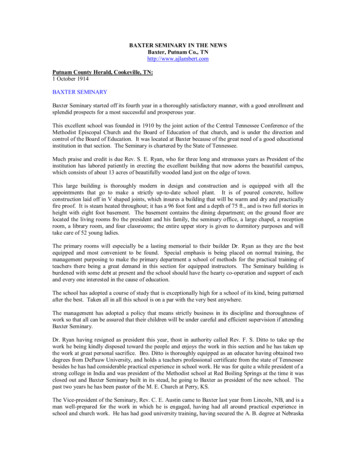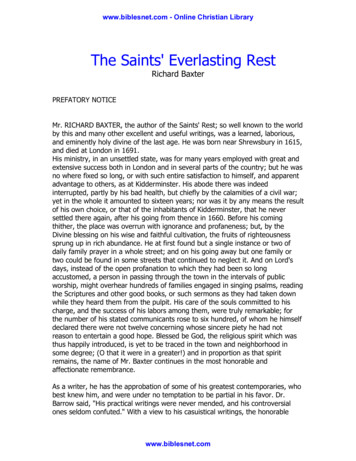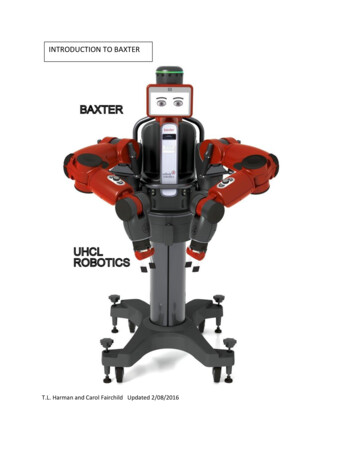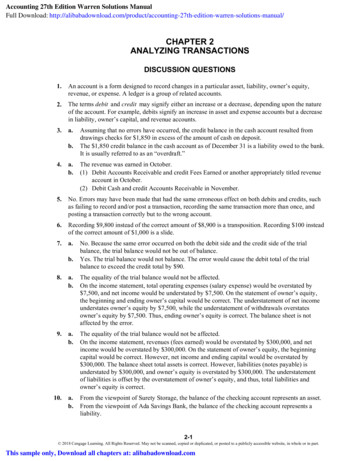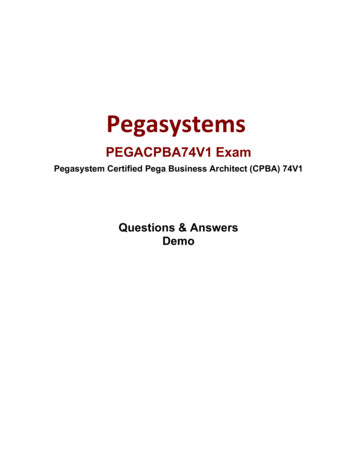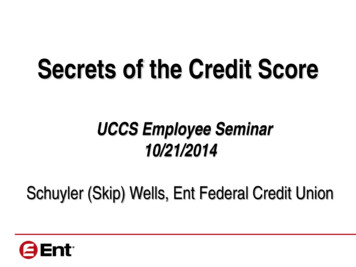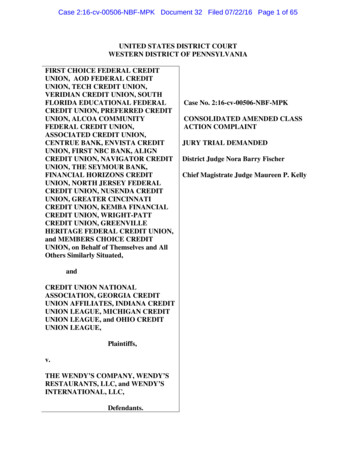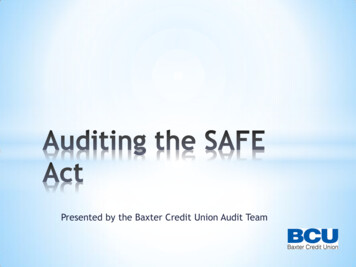
Transcription
Presented by the Baxter Credit Union Audit Team
1. Who offers Mortgage or Home Equity Loans?2. Do you perform your SAFE Act Audit in-house,or do you outsource it?3. Who in the room is your Credit Union’s SAFEAct Administrator?
1.2.3.4.5.Objectives of the SAFE ActHistory behind the SAFE ActDefinitionsRequirementsAuditing The SAFE Acta)b)c)d)e)f)Institution RegistrationProgram DocumentationIdentification of MLOsUse of Third Party ServicersRegistry InformationDisclosure Requirements
* Secure And Fair Enforcement for MortgageLicensing Act* Passed by Congress in July 2008* October 1, 2010 – Mandatory Due Date forCompliance for Federally Insured FinancialInstitutions* Affects all Mortgage Brokers, Banks, Thrifts, andCredit Unions
* Purpose to aggregate and improve information to andbetween regulators* Increased accountability and tracking of MortgageLoan Originators (MLOs)* Reduce Fraud in residential mortgage loanoriginations* Enhance Consumer protection* Provide the consumer with easily accessible informationregarding the employment and background of MLOs* Provide a means to warn consumers of disciplinary andenforcement actions taken against MLOs
*The Subprime Mortgage Crisis* First emerged in 2006* Subprime lending boom leading up to this periodcreated a “housing bubble”* Borrowers with poor credit history received high costmortgages* “No Doc, Low Doc” Loans – homeowners receivedmortgages they could not afford because theirfinancial qualifications were never verified* Adjustable rate mortgages that borrowers did notunderstand* Many borrowers got in financial difficulty as they couldnot afford escalating monthly payments or refinancetheir loans
* This lead to the Foreclosure Crisis* Foreclosure filings exceeded 3 million in 2008* Many desperate home owners fell victim toUnscrupulous Lenders engaged in predatory lendingpractices* Bogus offers of “cash back” refinance deals* Being told subprime loan rates would reset* Hidden, undisclosed closing costs* Mortgage Brokers were making a lot of money to thedetriment of borrowers
* In July 2008, Congress passed the SAFE Mortgage Licensing Act* Ensure all residential mortgage loan brokers and lenders meetbasic professional standards* Requires brokers and lenders to obtain a state license* Requires states to establish minimum standards for licensingrequirements* No felony convictions for at least 7 years* No similar license revoked* Demonstrated record of financial responsibility* Fulfilling minimum education requirements* Passing a written Exam* Enables consumers to verify whether their broker or lender hasa valid state license or is employed by a federally regulatedfinancial institution
* July 2010, Rules were published by the FFIEC RegulatoryAgencies for Federally Insured Financial Institutions* NCUA added Part 761 which established rules for theregistration of Residential Mortgage Loan Originatorsemployed by Credit Unions* Established additional requirements for State Chartered,non-Federally insured credit unions* Established the Nationwide Mortgage Licensing SystemRegistry* Compliance Date – October 1, 2010
* Mortgage Loan Originator (MLO)* An individual who takes a residential mortgage application.* Offers or negotiates terms of a residential mortgage loan forcompensation or gain.* Does not include individuals who perform administrative orclerical tasks (i.e., loan processors)* Receipt, collection and distribution of information commonto the processing or underwriting a loan.* Communication with a member to obtain informationnecessary for processing the loan.
* Nationwide Mortgage Licensing System and Registry(NMLS)* A system developed to register all MLOs, MortgageCompanies, and Financial Institutions* Maintained by the Conference of State Bank Supervisorsand American Association of Residential MortgageRegulators* The NMLS is intended to provide improved informationsharing among regulators, increased efficiencies for theindustry, and enhanced consumer protection* A key function of the NMLS is to provide consumersconfirmation that the firm or MLO they wish to conductbusiness with is authorized to conduct business in theirstate
Residential Mortgage Loan Any Loan primarily for personal, family, or household usethat is secured by a mortgage, deed of trust, or otherconsensual security interest on a dwelling. Residential Real Estate upon which a dwelling is beingconstructed or is intended to be constructed. Includes purchase, refinancing, reverse mortgages,home equity lines of credit, first and subordinate lienloansUnique Identifier A number assigned within the NMLS that identifies anMLOAnnual Renewal period November 1 through December 31 of each year
Do you know how many MLOs you have at yourcredit union?a)b)c)d)e)f)Less than 1010 to 2525 to 5050 to 100Over 100No Idea!
* Register the Financial Institution* Identify Primary Contact (and Backup)– Maintain the registry for CU and employees– Update registry as needed* Policies and Procedures* Procedures to ensure Third Parties comply with SAFEAct* Annual audit
Do you use a third party servicer to take realestate loan applications on your behalf?a)b)YesNo
* All Federally Insured CU’s must comply with NCUA Part 761* Examples of Non-Federally Insured Entities* NMLS Registration Requirements:– For State Chartered CU’s:– Primary Regulatory must enter into Memorandum of Understandingwith NCUA– Disclose that institution is not insured by NCUA– Oversight fees– Third Party Servicers:– Obtain state licensing and registration– Oversight fees
* All MLOs must be identified and registered unless:a)They have taken 5 or less applications within the past12 months and have not been previously registered.b)Their job description doesn’t include takingapplications.c)They are temporary help and will not be takingapplications for more than 6 months.d)They will only be taking applications for 3 months.
* All MLO’s must register prior to taking applications– Employment Information and Work History– Attestation– Fingerprinting– Criminal Background Check– Assign Unique Identifier* Previously Registered Employees* Annual Renewal and Attestation
* MLO must provide their unique identifier– Upon request– Before acting as a MLO– Through initial written communication with a consumer(paper or electronic)
* Four main auditable components:* Procedures and training materials have been created* Ensure that Credit Union, Program Administrator, andall qualifying MLOs are registered* MLO information is accurately recorded* Unique Identifier numbers are properly disclosed* Our audit approach is outlined on the followingslides
Do you know who your Program Administratoris?a)b)Yes!No
Requirement: Compliance with SAFE Act must be documented and allMLOs trained on SAFE Act requirements.Audit Steps:* Review Policies and Procedures for:*******Designation of Program AdministratorProcess to identify and register MLOs (including background checks andfingerprinting)When and how to disclose unique identifiersProcedures to confirm accuracy of NMLS Registry dataActions to be followed if employees do not comply with the SAFE ActProcedures to examine third party servicersAnnual testing (which is this audit)* Review training materials for:*****Registration requirementsUnique Identifier requirementsProvided unique identifier to applicantsUpdating information of NMLS RegistryAnnual renewal requirements
Can you identify which employees took anapplication?a)b)YesNo
Requirement: All employees who take more than 5 real estateapplications must be registered with the NMLS.Audit Steps:* Review the process to identify MLOs with the ProgramAdministrator, including monitoring of employees notregistered.* Obtain reports that show how many applications each personhad taken, and make sure that all MLOs who had taken over 5applications appeared on the Registry.* Review Registry to ensure that it does not contain terminatedemployees.
* Registration of Program Administrator (andbackup)* Registration of Credit Union – Check to makesure NMLS Registry is accurate
Requirement: Current MLO information must be provided to theNMLS Registry, and background checks must be performed beforeregistration.Audit Steps:* Compare identifying information submitted by employees intothe NMLS Registry to credit union records.* Determined that background checks and fingerprinting wereperformed through Program Administrator portal to NMLSRegistry* Compare recent changes made to employee records (address,phone number, email) to NMLS Registry to see if updates hadbeen made within 30 days of the change to credit union records* All MLOs have completed annual renewal process
Requirement: MLO numbers must be provided before anapplication is taken, on first written communication, and atthe member’s request.Audit Steps:* Spot check MLO phone calls to ensure that the UniqueIdentifier is being disclosed before the application is started.* Identify methods MLOs are first communicating with membersin writing* Ask MLOs to send copies of email to determine whether theycontain the proper Unique Identifier for both themselves and theinstitution.* Check initial disclosures for proper identifiers.* Determine if all staff know how to look up Unique Identifiersif a member asks.
Have you visited the NMLS Consumer AccessWebsite?a)b)c)YesNoThere’s a consumer access website?
http://www.nmlsconsumeraccess.org/site?
* Identify any third party servicers taking real estateapplications on the credit union’s behalf.* Ask if third party servicers can provide their proceduresto comply with the SAFE Act.* Review contract with them to ensure it had the followingprovisions:* Third party has taken steps to comply with the SAFE Act (andemployees can be found on the NMLS Registry)* Calls are recorded or monitoring documentation can beprovided* Right to audit clause
The Subprime Mortgage Crisis *First emerged in 2006 *Subprime lending boom leading up to this period created a "housing bubble" *Borrowers with poor credit history received high cost mortgages *"No Doc, Low Doc" Loans - homeowners received mortgages they could not afford because their financial qualifications were never verified


